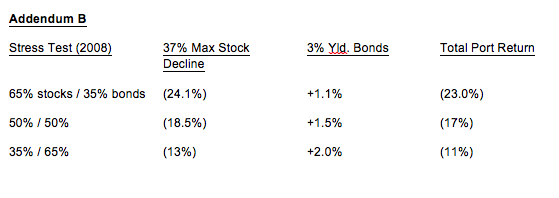By withdrawing less in retirement than the commonly accepted 4 percent rule (or 4.5 percent “Safe Max”), and instead using 3 percent to 3.5 percent retirees can substantially reduce losses should adverse market events occur. Also, through variable withdrawals (based upon a fixed percentage of the prior year-end valuation) principal protection can be improved. Unfortunately, all of these strategies may require a more modest lifestyle. We advise clients to adjust withdrawals to align with portfolio fluctuations, especially after impairment, and maintain this discipline until the portfolio recovers. Perhaps the best advice may be the hardest…put off full retirement until market conditions are more favorable (i.e. risk asset valuations, especially stocks, are lower) and assets are adequate given these more conservative withdrawal rates.
Addendum A
Why only 7 percent over a 20 year time period?
i. Lower growth…since 2005 U.S. GDP growth has averaged only 1.4 percent/yr.
ii. Consistent with lower GDP growth, we expect annual corporate earnings growth of mid-single digits. Since stock prices track earnings gains, future stock price appreciation is likely to be less than long-term averages. Other reasons for slower earnings growth include:
a) Profit margins have peaked and are declining
b) Wages are rising
c) World-wide GDP growth remains low
d) High debt levels mean less room for company financial engineering (stock buybacks)
e) Interest rates could rise over time increasing the overall cost of company debt

Steve Riley ([email protected]), CFA, CFP, and Rick Furmanski ([email protected]), CFA, CFP, are portfolio managers at Clearview Wealth Solutions in Lake Zurich, Ill.








